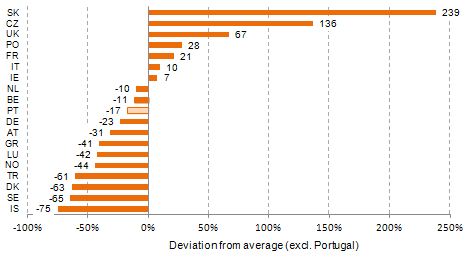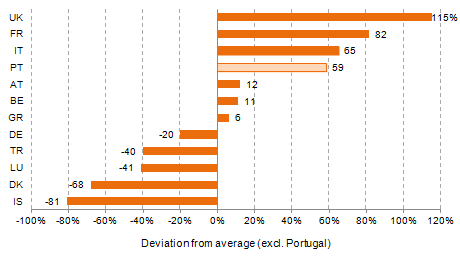Wholesale leased lines are a fundamental tool for the development of electronic communications services markets, leading also, to a large extent, to the development of transport and access networks throughout the national territory.
PTC's leased lines reference offers (LLRO and RELLO) support a significant percentage of leased lines, principally in the terminating segments and also in a significant proportion of trunk segments; these are relevant to the promotion of sustained competition in markets of electronic communications networks and services.
Recognizing that there are aspects of the LLRO and RELLO that require reviewing or updating, to bring them into line with market interests, on 14 June 2012, ICP-ANACOM approved a final decision on amendments to these offers.
As such, a notable set of amendments to the LLRO and RELLO were ordered, covering a broad range of obligations, such as a reduction in prices, reduction in time limits for the provision of leased lines and fault repair (the latter applying to Ethernet circuits), the application of compensation for non-compliance and the review of compensation, review of the "requirement forecast plan" to be submitted to PTC by beneficiaries, the update of levels of service - including premium levels - and the inclusion (in the RELLO) of information on quality of service parameters and other technical conditions.
Given that PTC's subsequent amendments to the LLRO were not fully compliant with the decision of 14 June 2012 (as regards prices for N × 64 Kbps leased lines with speeds exceeding 1,536 Kbps), on 11 October 2012, ICP-ANACOM determined corrections to LLRO prices in respect of such lines, with retroactive effect to 6 August 2012, when the amendments would have taken effect as resulting from the initial decision.
Given that the offer of Mainland - Azores - Madeira (CAM) and inter-island circuits constitute the only means by which alternative operators can provide communications with and within the autonomous regions of the Azores and Madeira, since there is no competition based on alternative infrastructure, in the same decision of 14 June 2012, ICP-ANACOM imposed specific conditions to govern this set of leased lines.
As such, provision was made for additional obligations governing the offer of CAM lines, particularly regarding the obligation to supply access (when included in the forecasts plan of the beneficiary operator) and the obligation of information on installed and available capacity on the transport network or the breakdown of quality of service indicators.
With regard to the backhaul service for access to CAM lines, it was determined that PTC must provide the co-location service in its landing point exchanges under the terms currently governing the remaining exchanges of its network, including services associated with connection between devices, such as signal transport. In this context, and also in connection with CAM lines, PTC is required to provide separate pricing for the non-submerged and submerged (backhaul) parts of CAM lines, whereas beneficiary operators may choose whether or not to use PTC's backhaul to access lines of this type.
With these amendments, the price of a 155 Mbps CAM line was reduced by 53%, in situations where the operator is co-located near the landing point.
A comparison of retail leased line prices performed by Teligen, based on data from November 20121, shows that prices charged in Portugal for circuits with lower speeds (2 Mbps) remain below the average of European countries analyzed, which is not the case with prices charged for circuits with higher speeds (34 Mbps).
The following graphs show the comparisons of retail prices charged for these types of lines, measured in terms of deviation from the average of countries considered2.
Graph 9. Annual price of 2 Mbps digital circuits in Europe (November 2012)

Source: ICP-ANACOM based on data from Teligen, November 2012 (Based on the OECD basket of distances, prices without VAT and without purchasing power parity).
Graph 10. Annual price of 34 Mbps digital circuits in Europe (November 2012)

Source: ICP-ANACOM based on data from Teligen, November 2012 (Based on the OECD basket of distances, prices without VAT and without purchasing power parity).
1 To conduct a comparison of prices for leased lines and calculate the average price of a circuit of determined capacity, Teligen takes into account the incumbent's prices in each country and used the basket of OECD distances involving six distance segments as a weighting:
|
Distances |
2 km |
20 km |
50 km |
100 km |
200 km |
500 km |
|
OECD basket |
35% |
20% |
15% |
20% |
5% |
5% |
2 The average is calculated excluding prices for Portugal.




